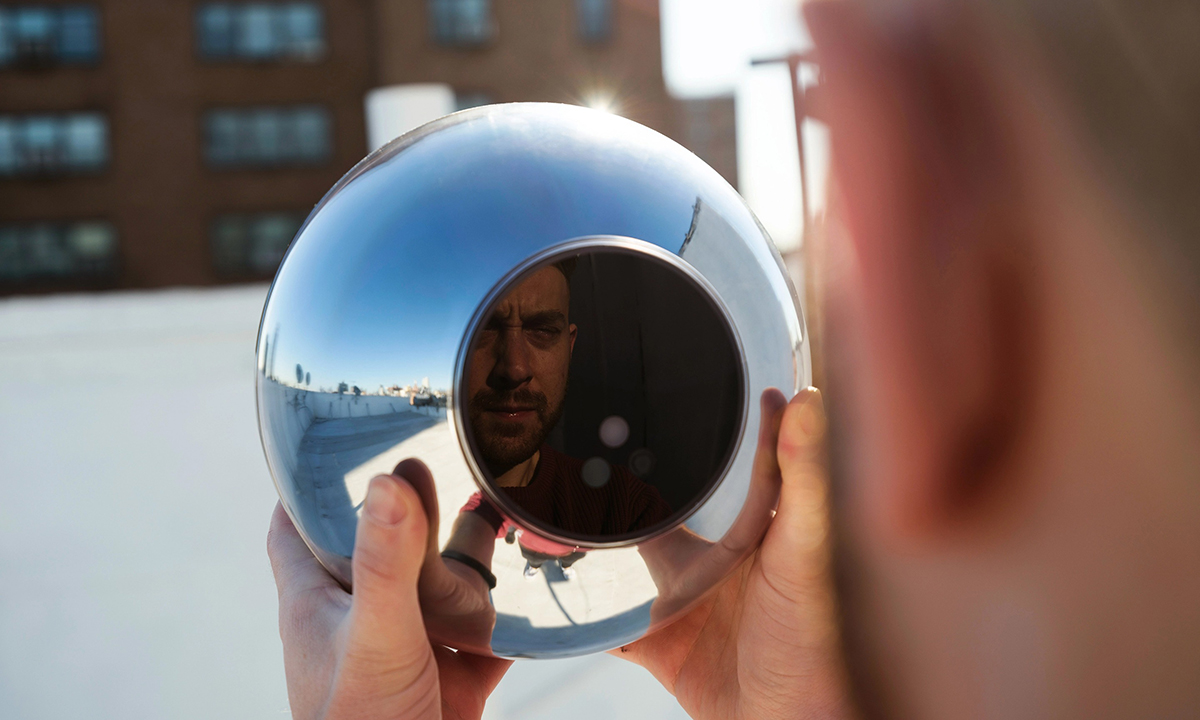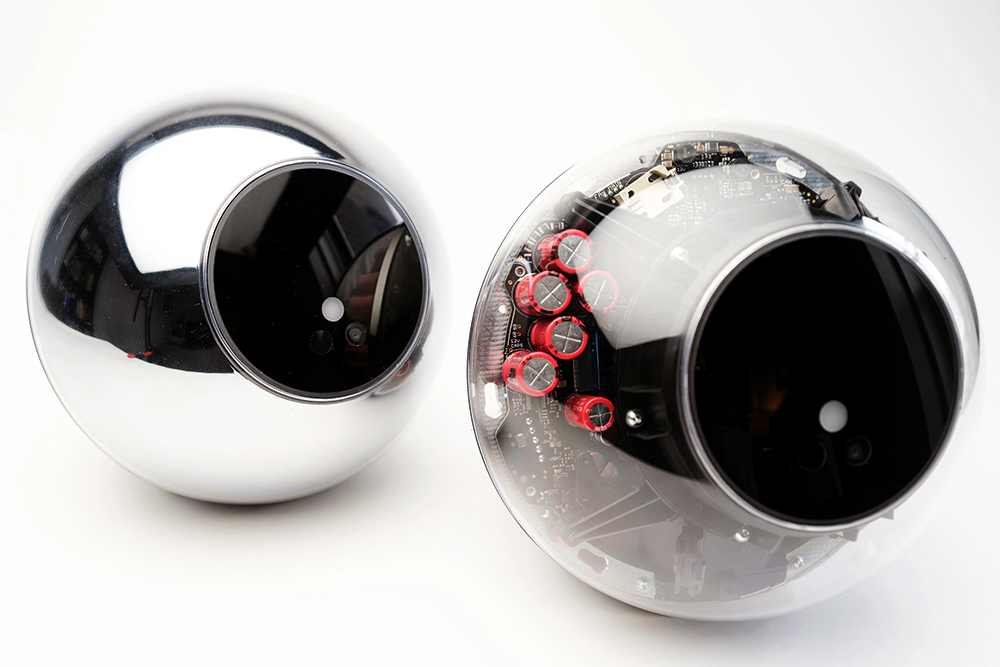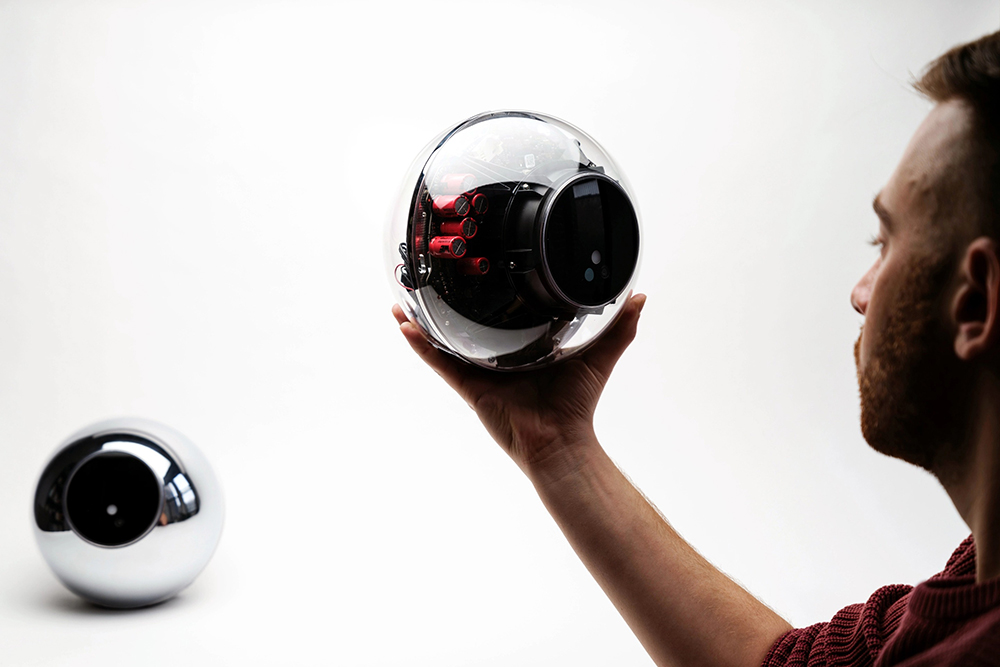
Worldcoin掃描球很像是史蒂夫·喬布斯設計的保齡球,也類似于超大號的HAL 9000(電影《2001太空漫游》中的超級計算機)所擁有的魔力8號球。整個球體的外表十分光滑,但止于前端的黑色圓形豁口,里面裝著三個感應器,呈三角形排列。
制作球形的物體對于工程學來說是一個噩夢,但其背后的重大象征意義卻不容忽視。該球體并非是正圓,而是由兩個半球拼湊而成,其拼接角度與地球的軌道相吻合。它的設計者是蘋果公司(Apple)的傳奇人物喬尼·艾夫招聘的第一個員工——托馬斯·邁耶霍夫爾。
掃描球雖然屬于驚艷之作,但它的功能卻十分簡單:掃描人的虹膜,并將生物特征圖片轉換為無法破解的一串數字,Worldcoin將其稱之為“虹膜密碼”(IrisCode)。通過結合相應的算法,這個密碼將證明你作為人類的獨特性。
每周約有4萬名民眾接受掃描。在今年3月一個寒冷的周日,我成為了其中一員,一名攜帶掃描球的Worldcoin員工來到了我在布魯克林的公寓。
我在這兩年間也讀到過關于這家公司的一些報道,因此也就欣然接受了與掃描球面對面接觸的機會。最終,當技術人員將它從一個特別設計的背包中取出來并與互聯網熱點相連之后,我看見了其內部的模樣。球體發出了嗶嗶啵啵的聲音,在掃描我的虹膜時亮起了白光和紅光,然后將加密結果傳回了數據中樞。在經歷了約45秒之后,我手機上的World應用程序亮了,顯示驗證已經成功。畢竟,我還是我自己。

這段時間以來,硅谷在新奇創意方面的表現不盡人意。期間“Uber-for-X”曾經再次現身。受此影響,風投資本的從眾心理將每一款應用程序轉換為其他公司的復制品。然而,即便這樣也是無力回天,因為專注于基礎設施或薪資軟件、以業務為中心的產品如雨后春筍般涌現。
作為對比,Worldcoin的錯誤倒是具有原創性,而且始于這個掃描球——它可能是自iPad以來最具標志性的硬件。它是這么標榜自己的:地球上有80億人。我們如何證明每個人都是真正的人類?Worldcoin的解決方案是通過隱私保護協定,對每個年滿18歲的人進行分類,并給每個人發放加密貨幣獎勵,而該加密貨幣反過來將成為新的全球貨幣標準。
“雄心壯志”一詞已經不足以描述這個理念以及聯合創始人、OpenAI的創建者薩姆·奧爾特曼。
在Worldcoin的計劃細節首次遭到泄露后的兩年時間中,批評聲接踵而至,從隱私顧慮、潛在的勞工虐待一直到理念過于怪異的看法。一落千丈的加密貨幣市場也給Worldcoin的全球征服策略蒙上了陰影。
OpenAI及其ChapGPT工具的驚艷亮相可能有助于扭轉Worldcoin的運勢。ChatGPT創紀錄的用戶增速,引發了風投資金的瘋狂涌入。
與Worldcoin高管、投資者和用戶的對話顯示,這兩家公司對不遠的將來有著共同的憧憬——它將是一個人工智能無處不在的未來,而且我們需要一支勢均力敵的力量,從而讓人類控制自己的命運。隨著Worldcoin奔向未來世界之際,該項目必須說服數十億民眾:公司正在致力于預防反烏托邦噩夢的出現,而不是在催生這一噩夢。
證明“人類特征”
Worldcoin的母公司Tools for Humanity的首席執行官亞歷克斯·布拉尼亞在2020年加入奧爾特曼最新創建的這家公司時正在攻讀理論物理學的博士學位。他受到了人工智能系統理念的感召,該理念呼吁向全球人口均等地發放金錢,并將其作為一種普遍的基本收入。
創始團隊早些時候還使用虹膜掃描來驗證布拉尼亞所稱的“人類特征”。布拉尼亞指出,指紋可以被篡改,而且面部的重新認證十分容易,但與更大的數據組進行對比幾乎是不可能的事情。司機的駕照或個人秘鑰可能會被偷盜或丟失,也有可能被復制或篡改。
布拉尼亞說:“我們知道這一點聽起來十分奇怪,而且我們自己在開始這個項目時也覺得十分奇怪。然而,此舉基本上是該問題的唯一解決方式。”
另一個困難就是說服其他人接受這一理念。獎勵是一種辦法:當人們接受掃描、驗證并上載至Worldcoin之后,他們會收到25枚被稱之為Worldcoin的專屬加密貨幣。這些代幣在未來可能會成為一筆財富,但在該項目大規模鋪開之前,這些代幣沒有什么價值可言。
居住在葡萄牙的一位30歲網絡企業家成為了較早接受掃描的人士,他通過聊天軟件Discord告訴我,他希望自己獲得的這些代幣在未來能夠價值連城。不過,他對于Worldcoin產品發布的不斷推遲感到失望。
在Worldcoin的試用過程中,公司還嘗試過發放其他獎勵,從加密貨幣,例如令人興奮的比特幣(Bitcoin)和泰達幣(Tether),一直到蘋果耳機AirPods,但依然不夠。
布拉尼亞回憶了自己當時拿著最初版本的虹膜掃描硬件在柏林東奔西走的情形,當時這個設備看起來像一個普通的藍色保齡球。沒有人愿意接受掃描。該團隊不斷更新其設計,一方面則是為了試試人們對其光滑銀色外表的反應。突然間,人們開始走到他面前。這個掃描球成了開啟對話的引子。
Worldcoin異常大膽的想法引發了頂級投資者的興趣,公司在2022年年初的估值達到了30億美元。在彭博社(Bloomberg)于2021年6月首次報道Worldcoin之后,掃描球很快吸引了大量的注意力和憤怒之聲。Worldcoin的高管和投資者對《財富》雜志表示,其中一部分是沖著其設計來的。
Variant Fund的聯合創始人及普通合伙人杰西·沃爾登說:“要想讓Worldcoin失敗,那就得確保沒有人可以知曉這款產品。”

即便如此,公司的抱負——打造“去中心化”的未來,這家總部位于硅谷的公司會對人類進行掃描和記錄——散發出與殖民主義相似的味道。不過,Worldcoin的母公司Tools for Humanity堅持認為這一流程在未來某一天將完全開源,并由非營利性機構Worldcoin Foundation運營。不出意外,這家公司遭到了大量的奚落和曝光,其中包括愛德華·斯諾登。他發表推文稱:“人類的身體并非是剪票鉗。”
在2022年4月緊挨著的兩天中,BuzzFeed News和《麻省理工科技評論》(MIT Tech Review)分別發布了調查。在這兩項調查里,記者控訴Worldcoin在發展中國家的試用充滿了欺騙性的承諾,承諾對象既有掃描球運營商,也有參與者。其他控訴包括違反隱私法,甚至是腐敗。
布拉尼亞稱這些報道有失公允,并表示出現這些問題的原因在于公司依然在進行驗收測試,并在這一過程中會自然而然地出現意外。他說:“很明顯,進展過程并不完美,而且很多事情需要改善。公司依然處于早期階段。”
布拉尼亞與 Tools for Humanity產品負責人蒂亞戈·薩達稱,該流程自那之后便一直處于優化當中,以確保隱私能夠得到充分保護。他們解釋說,在機器捕捉到虹膜之后,生物特征數據永遠都不會離開球體,而是會被轉化為虹膜密碼,該密碼僅用于通過復雜的零知識證明和原型Danksharding系統來創建有關個人獨特性的驗證。安德森-霍洛維茨公司(Andreessen Horowitz)的首席技術官埃迪·拉扎林堅持認為,虹膜密碼無法被逆轉,并被用于重構虹膜圖像,或至少現在是這樣。
如果這一切聽起來一頭霧水,那么重點在于,按照Worldcoin的話來講,公司已經設計了一個完美的系統來證明人類的獨特性,而且不會影響個人隱私保護。
全球性的加密貨幣
更大的問題在于,Worldcoin是否可以實現其幾乎異想天開的規模。繼2022年一連串不良新聞事件之后,Worldcoin悄然消失在人們的視野中,并進一步受到了加密貨幣寒冬的沖擊。它繼續招募新的參與者,但其節奏遠不及自己以前提出的目標,也就是在2022年年底之前獲得2,000萬至3,000萬注冊用戶,并生產6,000枚掃描球。如今,Worldcoin已經簽下了近140萬用戶,任何時間都有100枚至200枚掃描球在工作。以每周4萬個驗證的數量來看,公司需要近2,000年的時間才能夠完成全球當前近半數人口的注冊。不過,布拉尼亞稱,公司還遠未到滿負荷運轉的地步。
OpenAI與ChatGPT的爆發式增長重燃了公司對該項目的希望。這兩家公司始終都在齊頭并進,這也是薩姆·奧爾特曼愿景的一部分,即在這個由人工智能定義的世界中,應該創建一種公平有效的方式來分發人人可以享有的無條件基本收入(UBI)。他的這一愿景也得到了布拉尼亞及其投資者的認可。
布拉尼亞指出,希望在于,Worldcoin實際上能夠“讓盡可能多的人口獲得這項技術帶來的益處。”簡而言之,如果人工智能接手了我們的所有工作,Worldcoin就可以成為一種分發機制,以確保后續的資本創造不會把控在少數人的手中。
該項目的無條件基本收入抱負看起來依然不是很成熟。當我問及其機制時,Variant的沃爾登和a16z的拉扎林都拒絕回答,而且布拉尼亞模糊地提到了打造所謂的“意外條款”(Windfall Clause),一旦營收達到全球GDP的2.5%,這幾家公司就必須分享其營收。
“貨幣”元素本身也是十分微妙。盡管Tools for Humanity團隊希望Worldcoin在今后的規模能夠超越比特幣,甚至是美元,但Worldcoin代幣只有在所有人同意接受時才會有價值,這是個先有雞還是先有蛋的問題,說得好聽點是社會共識,說得難聽點就是龐氏騙局。
令局勢更為復雜的是,美國和其他首要國家的監管方是否會批準Worldcoin的加密貨幣。Worldcoin雇員提出要來我的公寓,目的是防止給人留下公司在紐約設有分支機構的印象。公司最終計劃在美國提供驗證服務,但不發行代幣。
除了其加密貨幣組件之外,Worldcoin不同的功能簡直完美契合人工智能的快速增長趨勢,即證明人類是人類。拉扎林表示:“每個人都有深度偽造的時候,而且也都會聽到語音合成。很明顯,要區分哪些是機器生成的內容以及哪些是人類制作的內容將變得越發困難。”
為了利用不斷增長的使用案例,并提供更為直接的貨幣化路線,Worldcoin在上周推出了一個功能,名為“世界身份”(World ID),這是人們在通過Worldcoin驗證后得到的一個徽章,可以在互聯網中佩戴,以證明你并非是人工智能機器。
在公司的愿景中,世界身份將加入或替代用戶名和密碼。登錄平臺的用戶將使用其World應用。在這個充斥著人工智能的世界里,該應用程序在證明某人身份時有望成為一種匿名效果較好的高大上解決方案。
隱私領域專家、牛津大學人工智能倫理研究所(Oxford’s Institute for Ethics in A.I.)的高級研究員伊麗莎白·雷尼爾斯稱,Worldcoin正在對自身進行定位,以便從薩姆·奧爾特曼這家知名公司創造的人工智能主導的社會中謀取收益。雷尼爾斯告訴我:“奧爾特曼的一家公司負責制造問題,另一家則負責出售針對該問題的解決方案。這種關系有點類似于醫藥公司先向市場推出危險的高度致癮藥物,然后嘗試出售治療這種成癮癥的新藥。”
布拉尼亞對此表示否認,稱人工智能的挑戰并不僅僅源于OpenAI。奧爾特曼并未提供任何采訪機會。
如今,Worldcoin依然處于驗收測試階段。盡管心懷去中心化的抱負,但公司并未完全公開其協定。不過,掃描球的大部分電路圖已經在GitHub上公布。布拉尼亞希望,其他人在未來某一天將創建自有的驗證設備,而Tools for Humanity將退至幕后。
然而,這家母公司還未公布該項目的代幣經濟學,也就是Worldcoin代幣鑄造與分發的具體細節。據知情人士透露,70%以上的代幣將流向Worldcoin注冊者,剩余的將流向Tools for Humanity及其投資者。公司可能會在2023年上半年發行代幣。
OpenAI征服互聯網的舉動依然在繼續,于3月中旬推出了其最新的大型語言模型的最新版本——GPT-4。與此同時,Worldcoin正在等待時機,而且制造了數千個新掃描球設備用于在全球范圍內使用,并豪賭數十億民眾將十分樂意一窺未來。(財富中文網)
譯者:馮豐
審校:夏林
Worldcoin掃描球很像是史蒂夫·喬布斯設計的保齡球,也類似于超大號的HAL 9000(電影《2001太空漫游》中的超級計算機)所擁有的魔力8號球。整個球體的外表十分光滑,但止于前端的黑色圓形豁口,里面裝著三個感應器,呈三角形排列。
制作球形的物體對于工程學來說是一個噩夢,但其背后的重大象征意義卻不容忽視。該球體并非是正圓,而是由兩個半球拼湊而成,其拼接角度與地球的軌道相吻合。它的設計者是蘋果公司(Apple)的傳奇人物喬尼·艾夫招聘的第一個員工——托馬斯·邁耶霍夫爾。
掃描球雖然屬于驚艷之作,但它的功能卻十分簡單:掃描人的虹膜,并將生物特征圖片轉換為無法破解的一串數字,Worldcoin將其稱之為“虹膜密碼”(IrisCode)。通過結合相應的算法,這個密碼將證明你作為人類的獨特性。
每周約有4萬名民眾接受掃描。在今年3月一個寒冷的周日,我成為了其中一員,一名攜帶掃描球的Worldcoin員工來到了我在布魯克林的公寓。
我在這兩年間也讀到過關于這家公司的一些報道,因此也就欣然接受了與掃描球面對面接觸的機會。最終,當技術人員將它從一個特別設計的背包中取出來并與互聯網熱點相連之后,我看見了其內部的模樣。球體發出了嗶嗶啵啵的聲音,在掃描我的虹膜時亮起了白光和紅光,然后將加密結果傳回了數據中樞。在經歷了約45秒之后,我手機上的World應用程序亮了,顯示驗證已經成功。畢竟,我還是我自己。
這段時間以來,硅谷在新奇創意方面的表現不盡人意。期間“Uber-for-X”曾經再次現身。受此影響,風投資本的從眾心理將每一款應用程序轉換為其他公司的復制品。然而,即便這樣也是無力回天,因為專注于基礎設施或薪資軟件、以業務為中心的產品如雨后春筍般涌現。
作為對比,Worldcoin的錯誤倒是具有原創性,而且始于這個掃描球——它可能是自iPad以來最具標志性的硬件。它是這么標榜自己的:地球上有80億人。我們如何證明每個人都是真正的人類?Worldcoin的解決方案是通過隱私保護協定,對每個年滿18歲的人進行分類,并給每個人發放加密貨幣獎勵,而該加密貨幣反過來將成為新的全球貨幣標準。
“雄心壯志”一詞已經不足以描述這個理念以及聯合創始人、OpenAI的創建者薩姆·奧爾特曼。
在Worldcoin的計劃細節首次遭到泄露后的兩年時間中,批評聲接踵而至,從隱私顧慮、潛在的勞工虐待一直到理念過于怪異的看法。一落千丈的加密貨幣市場也給Worldcoin的全球征服策略蒙上了陰影。
OpenAI及其ChapGPT工具的驚艷亮相可能有助于扭轉Worldcoin的運勢。ChatGPT創紀錄的用戶增速,引發了風投資金的瘋狂涌入。
與Worldcoin高管、投資者和用戶的對話顯示,這兩家公司對不遠的將來有著共同的憧憬——它將是一個人工智能無處不在的未來,而且我們需要一支勢均力敵的力量,從而讓人類控制自己的命運。隨著Worldcoin奔向未來世界之際,該項目必須說服數十億民眾:公司正在致力于預防反烏托邦噩夢的出現,而不是在催生這一噩夢。
證明“人類特征”
Worldcoin的母公司Tools for Humanity的首席執行官亞歷克斯·布拉尼亞在2020年加入奧爾特曼最新創建的這家公司時正在攻讀理論物理學的博士學位。他受到了人工智能系統理念的感召,該理念呼吁向全球人口均等地發放金錢,并將其作為一種普遍的基本收入。
創始團隊早些時候還使用虹膜掃描來驗證布拉尼亞所稱的“人類特征”。布拉尼亞指出,指紋可以被篡改,而且面部的重新認證十分容易,但與更大的數據組進行對比幾乎是不可能的事情。司機的駕照或個人秘鑰可能會被偷盜或丟失,也有可能被復制或篡改。
布拉尼亞說:“我們知道這一點聽起來十分奇怪,而且我們自己在開始這個項目時也覺得十分奇怪。然而,此舉基本上是該問題的唯一解決方式。”
另一個困難就是說服其他人接受這一理念。獎勵是一種辦法:當人們接受掃描、驗證并上載至Worldcoin之后,他們會收到25枚被稱之為Worldcoin的專屬加密貨幣。這些代幣在未來可能會成為一筆財富,但在該項目大規模鋪開之前,這些代幣沒有什么價值可言。
居住在葡萄牙的一位30歲網絡企業家成為了較早接受掃描的人士,他通過聊天軟件Discord告訴我,他希望自己獲得的這些代幣在未來能夠價值連城。不過,他對于Worldcoin產品發布的不斷推遲感到失望。
在Worldcoin的試用過程中,公司還嘗試過發放其他獎勵,從加密貨幣,例如令人興奮的比特幣(Bitcoin)和泰達幣(Tether),一直到蘋果耳機AirPods,但依然不夠。
布拉尼亞回憶了自己當時拿著最初版本的虹膜掃描硬件在柏林東奔西走的情形,當時這個設備看起來像一個普通的藍色保齡球。沒有人愿意接受掃描。該團隊不斷更新其設計,一方面則是為了試試人們對其光滑銀色外表的反應。突然間,人們開始走到他面前。這個掃描球成了開啟對話的引子。
Worldcoin異常大膽的想法引發了頂級投資者的興趣,公司在2022年年初的估值達到了30億美元。在彭博社(Bloomberg)于2021年6月首次報道Worldcoin之后,掃描球很快吸引了大量的注意力和憤怒之聲。Worldcoin的高管和投資者對《財富》雜志表示,其中一部分是沖著其設計來的。
Variant Fund的聯合創始人及普通合伙人杰西·沃爾登說:“要想讓Worldcoin失敗,那就得確保沒有人可以知曉這款產品。”
即便如此,公司的抱負——打造“去中心化”的未來,這家總部位于硅谷的公司會對人類進行掃描和記錄——散發出與殖民主義相似的味道。不過,Worldcoin的母公司Tools for Humanity堅持認為這一流程在未來某一天將完全開源,并由非營利性機構Worldcoin Foundation運營。不出意外,這家公司遭到了大量的奚落和曝光,其中包括愛德華·斯諾登。他發表推文稱:“人類的身體并非是剪票鉗。”
在2022年4月緊挨著的兩天中,BuzzFeed News和《麻省理工科技評論》(MIT Tech Review)分別發布了調查。在這兩項調查里,記者控訴Worldcoin在發展中國家的試用充滿了欺騙性的承諾,承諾對象既有掃描球運營商,也有參與者。其他控訴包括違反隱私法,甚至是腐敗。
布拉尼亞稱這些報道有失公允,并表示出現這些問題的原因在于公司依然在進行驗收測試,并在這一過程中會自然而然地出現意外。他說:“很明顯,進展過程并不完美,而且很多事情需要改善。公司依然處于早期階段。”
布拉尼亞與 Tools for Humanity產品負責人蒂亞戈·薩達稱,該流程自那之后便一直處于優化當中,以確保隱私能夠得到充分保護。他們解釋說,在機器捕捉到虹膜之后,生物特征數據永遠都不會離開球體,而是會被轉化為虹膜密碼,該密碼僅用于通過復雜的零知識證明和原型Danksharding系統來創建有關個人獨特性的驗證。安德森-霍洛維茨公司(Andreessen Horowitz)的首席技術官埃迪·拉扎林堅持認為,虹膜密碼無法被逆轉,并被用于重構虹膜圖像,或至少現在是這樣。
如果這一切聽起來一頭霧水,那么重點在于,按照Worldcoin的話來講,公司已經設計了一個完美的系統來證明人類的獨特性,而且不會影響個人隱私保護。
全球性的加密貨幣
更大的問題在于,Worldcoin是否可以實現其幾乎異想天開的規模。繼2022年一連串不良新聞事件之后,Worldcoin悄然消失在人們的視野中,并進一步受到了加密貨幣寒冬的沖擊。它繼續招募新的參與者,但其節奏遠不及自己以前提出的目標,也就是在2022年年底之前獲得2,000萬至3,000萬注冊用戶,并生產6,000枚掃描球。如今,Worldcoin已經簽下了近140萬用戶,任何時間都有100枚至200枚掃描球在工作。以每周4萬個驗證的數量來看,公司需要近2,000年的時間才能夠完成全球當前近半數人口的注冊。不過,布拉尼亞稱,公司還遠未到滿負荷運轉的地步。
OpenAI與ChatGPT的爆發式增長重燃了公司對該項目的希望。這兩家公司始終都在齊頭并進,這也是薩姆·奧爾特曼愿景的一部分,即在這個由人工智能定義的世界中,應該創建一種公平有效的方式來分發人人可以享有的無條件基本收入(UBI)。他的這一愿景也得到了布拉尼亞及其投資者的認可。
布拉尼亞指出,希望在于,Worldcoin實際上能夠“讓盡可能多的人口獲得這項技術帶來的益處。”簡而言之,如果人工智能接手了我們的所有工作,Worldcoin就可以成為一種分發機制,以確保后續的資本創造不會把控在少數人的手中。
該項目的無條件基本收入抱負看起來依然不是很成熟。當我問及其機制時,Variant的沃爾登和a16z的拉扎林都拒絕回答,而且布拉尼亞模糊地提到了打造所謂的“意外條款”(Windfall Clause),一旦營收達到全球GDP的2.5%,這幾家公司就必須分享其營收。
“貨幣”元素本身也是十分微妙。盡管Tools for Humanity團隊希望Worldcoin在今后的規模能夠超越比特幣,甚至是美元,但Worldcoin代幣只有在所有人同意接受時才會有價值,這是個先有雞還是先有蛋的問題,說得好聽點是社會共識,說得難聽點就是龐氏騙局。
令局勢更為復雜的是,美國和其他首要國家的監管方是否會批準Worldcoin的加密貨幣。Worldcoin雇員提出要來我的公寓,目的是防止給人留下公司在紐約設有分支機構的印象。公司最終計劃在美國提供驗證服務,但不發行代幣。
除了其加密貨幣組件之外,Worldcoin不同的功能簡直完美契合人工智能的快速增長趨勢,即證明人類是人類。拉扎林表示:“每個人都有深度偽造的時候,而且也都會聽到語音合成。很明顯,要區分哪些是機器生成的內容以及哪些是人類制作的內容將變得越發困難。”
為了利用不斷增長的使用案例,并提供更為直接的貨幣化路線,Worldcoin在上周推出了一個功能,名為“世界身份”(World ID),這是人們在通過Worldcoin驗證后得到的一個徽章,可以在互聯網中佩戴,以證明你并非是人工智能機器。
在公司的愿景中,世界身份將加入或替代用戶名和密碼。登錄平臺的用戶將使用其World應用。在這個充斥著人工智能的世界里,該應用程序在證明某人身份時有望成為一種匿名效果較好的高大上解決方案。
隱私領域專家、牛津大學人工智能倫理研究所(Oxford’s Institute for Ethics in A.I.)的高級研究員伊麗莎白·雷尼爾斯稱,Worldcoin正在對自身進行定位,以便從薩姆·奧爾特曼這家知名公司創造的人工智能主導的社會中謀取收益。雷尼爾斯告訴我:“奧爾特曼的一家公司負責制造問題,另一家則負責出售針對該問題的解決方案。這種關系有點類似于醫藥公司先向市場推出危險的高度致癮藥物,然后嘗試出售治療這種成癮癥的新藥。”
布拉尼亞對此表示否認,稱人工智能的挑戰并不僅僅源于OpenAI。奧爾特曼并未提供任何采訪機會。
如今,Worldcoin依然處于驗收測試階段。盡管心懷去中心化的抱負,但公司并未完全公開其協定。不過,掃描球的大部分電路圖已經在GitHub上公布。布拉尼亞希望,其他人在未來某一天將創建自有的驗證設備,而Tools for Humanity將退至幕后。
然而,這家母公司還未公布該項目的代幣經濟學,也就是Worldcoin代幣鑄造與分發的具體細節。據知情人士透露,70%以上的代幣將流向Worldcoin注冊者,剩余的將流向Tools for Humanity及其投資者。公司可能會在2023年上半年發行代幣。
OpenAI征服互聯網的舉動依然在繼續,于3月中旬推出了其最新的大型語言模型的最新版本——GPT-4。與此同時,Worldcoin正在等待時機,而且制造了數千個新掃描球設備用于在全球范圍內使用,并豪賭數十億民眾將十分樂意一窺未來。(財富中文網)
譯者:馮豐
審校:夏林
The Worldcoin orb resembles a bowling ball conceived by Steve Jobs or an oversized Magic 8 ball possessed by HAL 9000. Its glossy exterior envelops the sphere, save for a gaping black circle in the front that houses three sensors positioned in a triangle.
Making the object round was an engineering nightmare, but the symbolism was too vital to ignore. The orb isn’t a perfect sphere but two halves that come together at an angle that matches the orbit of the Earth—designed by Thomas Meyerhoffer, the first hire of Apple legend Jony Ive.
Architectural marvel that it is, the orb serves a simple purpose: It scans your iris and converts the biometric image into an impenetrable string of numbers, which Worldcoin refers to as an “IrisCode.” When combined with an algorithm, the code verifies you’re a unique human.
Each week, about 40,000 people subject themselves to the scan. On a chilly Sunday in March, I became one of them, with an orb-carrying Worldcoin employee stopping by my cramped Brooklyn apartment.
After two years of reading about the company, I welcomed the opportunity to meet the orb face-to-face. Finally, once the technician wrestled it from a specially designed backpack and connected it to an internet hotspot, I was able to stare into its depths. The orb responded with beeps and bops, lighting up white and red as it scanned my iris and beamed the encoded results back to the mothership. After about 45 seconds, the World App on my phone illuminated, revealing that I had been successfully verified. I was myself, after all.
Silicon Valley these days is short on fanciful ideas. There’s the “Uber-for-X” reprise, where the venture capital herd mentality has turned every app into a facsimile of some other company, but even that has ceded to the proliferation of business-focused products focused on infrastructure or payroll software.
Worldcoin, in contrast, might be original to a fault, starting with the orb—perhaps the most iconic piece of hardware since the iPad. Then comes the pitch: There are 8 billion people on Earth. How do we prove each person is real? Worldcoin’s solution is cataloging every individual over 18 years old through a privacy-preserving protocol, rewarding each person with cryptocurrency, which in turn will become the new global monetary standard.
The word “ambitious” doesn’t do justice to either the idea or cofounder Sam Altman, also the creator of OpenAI.
In the two years since details of Worldcoin’s plan first leaked, the company has been hit with criticism ranging from privacy concerns to potential labor abuses to just how strange it is. And plummeting crypto markets did not help Worldcoin’s globe-conquering strategy.
The stunning rise of OpenAI and its ChatGPT tool, which set records for user adoption and spurred a flood of venture funding, may have helped reverse Worldcoin’s fortunes.
Conversations with Worldcoin executives, investors, and users have illuminated the shared dream of a not-too-distant future between the two companies—one where artificial intelligence pervades society, and we need a countervailing force to keep humans in control of their destinies. As Worldcoin barrels toward that tomorrowland, the project will have to convince billions of people that it’s committed to preventing—not creating—some dystopian nightmare.
Proving “humanness”
Alex Blania, CEO of Worldcoin parent company Tools for Humanity, was studying for a Ph.D. in theoretical physics in 2020 when he joined Sam Altman’s latest brainchild, lured by the idea of an A.I.-powered system for evenly distributing money to the world’s population, a form of universal basic income.
The founding team early on settled on iris scans as the method to authenticate what Blania refers to as “humanness.” Fingerprints can be changed, he says, and faces are easy to reauthenticate but nearly impossible to compare against a larger set. A driver’s license or a private key could be stolen or lost, copied or tampered with.
“We know it sounds weird—and it sounded weird to us as well when we started the project—but it is fundamentally the only way to solve that problem,” Blania says.
The next dilemma was convincing people to sign up. Offering a reward is one solution: When a person is scanned, verified, and onboarded to Worldcoin, they are given 25 proprietary crypto tokens, which are also called Worldcoins. The tokens may carry the promise of future riches, but they’re worthless unless the project launches at scale.
One early adopter, a 30-year-old online entrepreneur living in Portugal, told me over Discord that he hopes his tokens will be worth millions, although he’s been disappointed that Worldcoin keeps delaying the release.
In Worldcoin’s trials, the company also experimented with other rewards, from cryptocurrencies such as wrapped Bitcoin and Tether to AirPods. That still wasn’t enough.
Blania recalls running around Berlin with one of the earliest iterations of the hardware that would capture people’s irises, which at the time looked like a normal blue bowling ball. He couldn’t get anyone to sign up. The team continued to iterate on the design, at one point testing out its sleek, silver exterior. Suddenly, people started coming up to him. The orb became a conversation starter.
The sheer audacity of Worldcoin attracted top investors, with the company reaching a valuation of $3 billion by early 2022. After Bloomberg first reported on Worldcoin in June 2021, the orb quickly became a lightning rod for attention and outrage. Part of that was by design, Worldcoin’s executives and investors told Fortune.
“The surest way for Worldcoin to fail is for nobody to hear about it,” says Jesse Walden, a cofounder and general partner at Variant Fund.
Even so, the company’s aspirations—a “decentralized” future where people are scanned and recorded by a Silicon Valley-backed company—had the familiar whiff of colonialism, although Worldcoin’s parent company, Tools for Humanity, insists that the process will someday be fully open-source and run by the nonprofit Worldcoin Foundation. Unsurprisingly, the company has suffered a torrent of ridicule and exposes, including from Edward Snowden, who tweeted that “the human body is not a ticket-punch.”
In two investigations, published on back-to-back days in April 2022 by BuzzFeed News and MIT Tech Review, journalists alleged that Worldcoin trials in developing countries were riddled with deceptive promises made both to orb operators and participants. Other allegations included privacy law violations and even corruption.
Blania called the reporting unfair, adding that the problems stemmed from the company still being in beta testing and hitting natural snags in the process. “Obviously things have not been perfect, and many things needed to improve,” he says. “The company is still very early.”
According to Blania and Tiago Sada, Tools for Humanity’s head of product, the process has since been perfected to ensure total privacy. After a person’s iris is captured, the biometric data never leaves the orb, they explain, instead converting it into the IrisCode, which itself is only used to create a verification of a person’s uniqueness through a convoluted system of zero-knowledge proofs and proto-danksharding. Eddy Lazzarin, the crypto CTO at Andreessen Horowitz, insists the IrisCode cannot be reversed to reconstruct the image of an iris—or at least not yet.
If that all sounds like gibberish, the upshot is that, according to Worldcoin, the company has devised a perfect system to prove human uniqueness in a way that won’t compromise privacy.
Crypto for the world
The bigger question is whether Worldcoin can achieve its almost impossibly ambitious scale. After last year’s spate of bad press, Worldcoin slunk into the background, further buffeted by the chill of the Crypto Winter. It continued to onboard new participants but was far off from its once-stated pace of having 20 million to 30 million registrants and 6,000 orbs by the end of 2022. Today, Worldcoin has signed up around 1.4 million people, with between 100 and 200 orbs operational at any given time. At the rate of 40,000 verifications a week, it would take almost 2,000 years to sign up half the world’s current population, although Blania says the company is far from operating at full capacity.
The explosion of OpenAI and ChatGPT has reignited hope for the project. The two companies always skated in parallel, part of Sam Altman’s vision—shared by Blania and his investors—that in a world defined by A.I., there would have to be a fair and efficient way of dispersing a universal basic income.
The hope, Blania says, is that Worldcoin can “actually distribute the upside of all this tech for as many people as possible.” Put more simply, if artificial intelligence takes all our jobs, Worldcoin can be the mechanism of distribution to make sure ensuing capital creation is not hoarded by a select few.
The UBI aspirations for the project still seem half-baked. Both Variant’s Walden and a16z’s Lazzarin demurred when I asked about the mechanics, and Blania answered vaguely about creating a so-called “Windfall Clause” where companies would have to share their revenues once they reach 2.5% of the global GDP.
The “currency” element itself is also tricky. While the Tools for Humanity team hopes Worldcoin will someday become bigger than Bitcoin, or even the U.S. dollar, the Worldcoin token will only have value if everyone agrees to adopt it—a chicken-and-egg dilemma that could euphemistically be called social consensus and derisively a pyramid scheme.
Complicating matters further is whether regulators in the U.S.—and other key countries—will ever permit Worldcoin’s crypto token. The Worldcoin employee offered to come to my apartment to prevent any impression that the company was operational in New York. The company plans to eventually offer the verification service in the U.S.—without the token.
Outside its cryptocurrency component, a different feature of Worldcoin is more immediately suited to A.I.’s rapid rise: proving humans are human. “Everybody has seen deepfakes, and everybody hears voice synthesis,” says Lazzarin. “It’s very clear that it’s going to become more and more difficult to disentangle what was generated by a machine and what was generated by a person.”
To capitalize on the growing use case—and offer a more immediate route to monetization—Worldcoin launched a feature last week called “World ID,” a kind of badge you receive after being verified by Worldcoin that you carry around the internet proving that you’re not an A.I. bot.
In the company’s vision, World ID will join—or supplant—usernames and passwords. Users logging onto platforms will use their World Apps, which, in an A.I.-saturated world, could be an elegant and relatively anonymous solution to proving one’s identity.
Elizabeth Renieris, a privacy expert and senior research associate at Oxford’s Institute for Ethics in A.I., says Worldcoin is just positioning itself to profit off an A.I.-dominated society created by Sam Altman’s higher-profile company.
“One Altman entity manufactures a problem, and the other sells a solution to the problem they manufactured,” Renieris tells me. “The relationship is a bit like pharmaceutical companies who place dangerous, highly addictive drugs on the market and then try to sell new drugs to treat the very addiction they helped create.”
Blania denied the charge, saying challenges around artificial intelligence won’t only originate from OpenAI. Altman did not make himself available for an interview.
For now, Worldcoin remains in beta. Despite its decentralized aspirations, it has yet to fully open-source its protocol, though most of the orb’s schematics are available on GitHub. Blania hopes that someday other people will create their own verification objects, with Tools for Humanity receding into the background.
The parent company, however, has yet to release even the tokenomics of the project—the breakdown of how Worldcoins will be minted and distributed. A person familiar with the matter said that upward of 70% of the tokens will go to Worldcoin registrants, with the rest going to Tools for Humanity and its investors. The token launch could happen in the first half of 2023.
OpenAI continues to conquer the internet, launching its newest language model system, GPT-4, in mid-March. Worldcoin, meanwhile, is biding its time, manufacturing thousands of new orbs to disperse around the globe and betting that billions of people will be willing to stare into the future.






